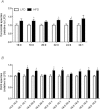Consumption of a high-fat diet, but not regular endurance exercise training, regulates hypothalamic lipid accumulation in mice
- PMID: 22674717
- PMCID: PMC3473292
- DOI: 10.1113/jphysiol.2012.233288
Consumption of a high-fat diet, but not regular endurance exercise training, regulates hypothalamic lipid accumulation in mice
Abstract
Obesity is characterised by increased storage of fatty acids in an expanded adipose tissue mass and in peripheral tissues such as the skeletal muscle and liver, where it is associated with the development of insulin resistance. Insulin resistance also develops in the central nervous system with high-fat feeding. The capacity for hypothalamic cells to accumulate/store lipids, and the effects of obesity remain undefined. The aims of this study were (1) to examine hypothalamic lipid content in mice with increased dietary fat intake and in obese ob/ob mice fed a low-fat diet, and (2) to determine whether endurance exercise training could reduce hypothalamic lipid accumulation in high-fat fed mice. Male C57BL/6 mice were fed a low- (LFD) or high-fat diet (HFD) for 12 weeks; ob/ob mice were maintained on a chow diet. HFD-exercise (HFD-ex) mice underwent 12 weeks of high-fat feeding with 6 weeks of treadmill exercise training (increasing from 30 to 70 min day(-1)). Hypothalamic lipids were assessed by unbiased mass spectrometry. The HFD increased body mass and hepatic lipid accumulation, and induced glucose intolerance, while the HFD-ex mice had reduced body weight and improved glucose tolerance. A total of 335 lipid molecular species were identified and quantified. Lipids known to induce insulin resistance, including ceramide (22%↑), diacylglycerol (25%↑), lysophosphatidylcholine (17%↑), cholesterol esters (60%↑) and dihexosylceramide (33%↑), were increased in the hypothalamus of HFD vs. LFD mice. Hypothalamic lipids were unaltered with exercise training and in the ob/ob mice, suggesting that obesity per se does not alter hypothalamic lipids. Overall, hypothalamic lipid accumulation is regulated by dietary lipid content and is refractory to change with endurance exercise training.
Figures





Comment in
-
Fat on the brain.J Physiol. 2012 Sep 1;590(17):4121. doi: 10.1113/jphysiol.2012.239491. J Physiol. 2012. PMID: 22962031 Free PMC article. No abstract available.
Similar articles
-
Evidence that diet-induced hyperleptinemia, but not hypothalamic gliosis, causes ghrelin resistance in NPY/AgRP neurons of male mice.Endocrinology. 2014 Jul;155(7):2411-22. doi: 10.1210/en.2013-1861. Epub 2014 Apr 17. Endocrinology. 2014. PMID: 24742194
-
A high-fat diet supplemented with medium-chain triglycerides ameliorates hepatic steatosis by reducing ceramide and diacylglycerol accumulation in mice.Exp Physiol. 2024 Mar;109(3):350-364. doi: 10.1113/EP091545. Epub 2024 Jan 9. Exp Physiol. 2024. PMID: 38192209 Free PMC article.
-
Voluntary exercise improves hypothalamic and metabolic function in obese mice.J Endocrinol. 2016 May;229(2):109-22. doi: 10.1530/JOE-15-0510. Epub 2016 Mar 1. J Endocrinol. 2016. PMID: 26931136
-
The Role of Fatty Acids in Ceramide Pathways and Their Influence on Hypothalamic Regulation of Energy Balance: A Systematic Review.Int J Mol Sci. 2021 May 19;22(10):5357. doi: 10.3390/ijms22105357. Int J Mol Sci. 2021. PMID: 34069652 Free PMC article.
-
Cardio-Metabolic Effects of High-Fat Diets and Their Underlying Mechanisms-A Narrative Review.Nutrients. 2020 May 21;12(5):1505. doi: 10.3390/nu12051505. Nutrients. 2020. PMID: 32455838 Free PMC article. Review.
Cited by
-
Injury to hypothalamic Sim1 neurons is a common feature of obesity by exposure to high-fat diet in male and female mice.J Neurochem. 2019 Apr;149(1):73-97. doi: 10.1111/jnc.14662. Epub 2019 Feb 11. J Neurochem. 2019. PMID: 30615192 Free PMC article.
-
Mild lipid stress induces profound loss of MC4R protein abundance and function.Mol Endocrinol. 2014 Mar;28(3):357-67. doi: 10.1210/me.2013-1357. Epub 2014 Feb 7. Mol Endocrinol. 2014. PMID: 24506538 Free PMC article.
-
Ceramides are fuel gauges on the drive to cardiometabolic disease.Physiol Rev. 2024 Jul 1;104(3):1061-1119. doi: 10.1152/physrev.00008.2023. Epub 2024 Feb 1. Physiol Rev. 2024. PMID: 38300524 Free PMC article. Review.
-
Fatty Acid Increases cAMP-dependent Lactate and MAO-B-dependent GABA Production in Mouse Astrocytes by Activating a Gαs Protein-coupled Receptor.Exp Neurobiol. 2018 Oct;27(5):365-376. doi: 10.5607/en.2018.27.5.365. Epub 2018 Oct 31. Exp Neurobiol. 2018. PMID: 30429646 Free PMC article.
-
Contribution of specific ceramides to obesity-associated metabolic diseases.Cell Mol Life Sci. 2022 Jul 5;79(8):395. doi: 10.1007/s00018-022-04401-3. Cell Mol Life Sci. 2022. PMID: 35789435 Free PMC article. Review.
References
-
- Andersson A, Sjodin A, Olsson R, Vessby B. Effects of physical exercise on phospholipid fatty acid composition in skeletal muscle. Am J Physiol Endocrinol Metab. 1998;274:E432–438. - PubMed
-
- Benoit SC, Kemp CJ, Elias CF, Abplanalp W, Herman JP, Migrenne S, Lefevre AL, Cruciani-Guglielmacci C, Magnan C, Yu F, Niswender K, Irani BG, Holland WL, Clegg DJ. Palmitic acid mediates hypothalamic insulin resistance by altering PKC-theta subcellular localization in rodents. J Clin Invest. 2009;119:2577–2589. - PMC - PubMed
-
- Bronfman M, Morales MN, Orellana A. Diacylglycerol activation of protein kinase C is modulated by long-chain acyl-CoA. Biochem Biophys Res Commun. 1988;152:987–992. - PubMed
-
- Bruce CR, Thrush AB, Mertz VA, Bezaire V, Chabowski A, Heigenhauser GJ, Dyck DJ. Endurance training in obese humans improves glucose tolerance and mitochondrial fatty acid oxidation and alters muscle lipid content. Am J Physiol Endocrinol Metab. 2006;291:E99–E107. - PubMed
Publication types
MeSH terms
Substances
LinkOut - more resources
Full Text Sources
Molecular Biology Databases
Miscellaneous

